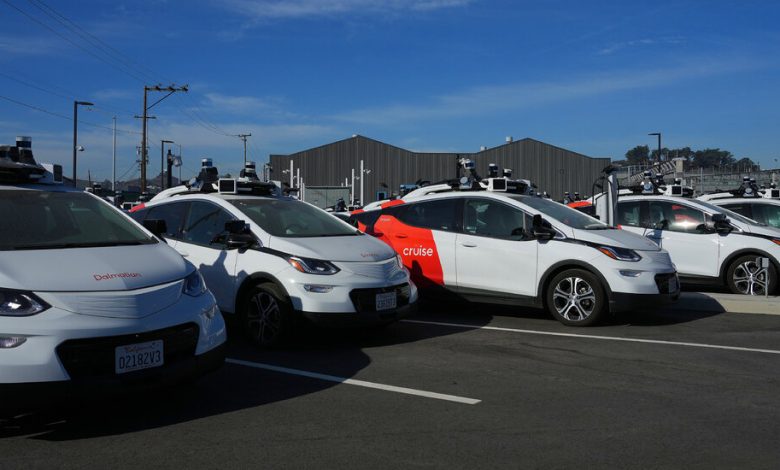Struggling Cruise Cuts About 25 Percent of Its Workers

Cruise, the embattled self-driving car subsidiary of General Motors, said on Thursday that it would eliminate about 900 jobs, roughly a quarter of its work force, as the company looked to rein in costs after an October incident led California regulators to shut down its robot taxi operations.
Most of the job cuts are in corporate and commercial roles, which have become less important since the company voluntarily suspended all its driverless operations across the country in October. The shut down came two days after California’s Department of Motor Vehicles said that the company “misrepresented” its technology and ordered Cruise to stop operating in the state.
Cruise’s troubles can be traced to an Oct. 2 crash when a car hit a woman at an intersection in San Francisco and flung her into the path of one of Cruise’s driverless taxis. The Cruise car dragged the woman some 20 feet before pulling to the curb, causing severe injuries. Regulators accused Cruise of omitting footage of its car dragging the woman from a video that it provided to state officials.
The accident — and its fallout — have called into question the future of the tech and auto industry’s pursuit of self-driving cars. Since Google started working on the first autonomous vehicle more than a decade ago, dozens of companies have poured tens of billions of dollars into building software and persuading regulators to permit testing on roads around the country.
But many driverless car executives now worry that Cruise’s troubles could lead regulators to increase their enforcement and scrutiny of the nascent technology. And financial pressures have been mounting for start-ups that sell sensors and other technology to self-driving car companies.
Waymo, a division of Google’s parent company Alphabet, is still offering a driverless taxi service in San Francisco. The industry’s leaders consider the city to be a critical proving ground for the technology’s potential and the viability of the $8 trillion market that it could create.
“The problem isn’t just the technology, which is a problem,” said Mike Ramsey, an automotive analyst focused on the self-driving car industry at Gartner, a tech research firm. “It’s always been about the business model. There’s been a desperation for it to make sense to do this, and they still haven’t found a way to justify it.”
G.M., which bought Cruise in 2016 for $1 billion, has stepped in to steer the self-driving car company forward. In November, Cruise hired the law firm Quinn Emanuel to investigate the crash and Cruise’s response. The driverless carmaker’s founders, Kyle Vogt and Dan Kan, resigned last month. And yesterday, the company dismissed nine senior executives, including its heads of operations and government affairs.
Instead of installing a new chief executive, G.M. appointed two presidents who are reporting to its board: Mo Elshenawy, Cruise’s executive vice president of engineering, and Craig Glidden, G.M.’s general counsel.
The company has been preparing employees for layoffs for more than a month; in late October, Mr. Vogt told employees in a companywide meeting that the loss of sales from ceasing operations would result in cuts.
“We knew this day was coming, but that does not make it any less difficult — especially for those whose jobs are affected,” Mr. Elshenawy said in an email to staff on Thursday, which was posted on the company’s website.
Cruise said laid off employees would continue to receive their pay through April 8, have health benefits through May and get their 2023 bonuses. News of the dismissals was reported earlier by the tech news site TechCrunch.
The layoffs come at the end of a year of cutbacks across the tech industry. Big tech companies including Microsoft and Google’s parent company, Alphabet, eliminated tens of thousands of jobs this year as they tried to reduce costs after hiring too many employees during the pandemic.
While most tech businesses have rebounded and begun rebuilding their work forces, the future of Cruise is less clear. The company expects Quinn Emanuel to wrap up its report early next year, according to two people familiar with the investigation. The company will make some, if not all, of the report publicly available.
Mr. Vogt, 38, should feature prominently in the law firm’s report. Under his direction, Cruise prioritized rapidly expanding its driverless fleet to beat its top rival, Waymo, into new markets.
In April, Cruise began offering driverless taxi rides throughout the day in San Francisco. Its 400 cars quickly racked up headlines for a number of issues, including a collision with a fire truck and another incident where a vehicle drove into wet concrete and got stuck.
In an interview with The New York Times in September, Mr. Vogt said that Cruise cars created more headlines over issues than Waymo because it was operating a bigger fleet.
“I haven’t seen any evidence suggesting that either company is operating unsafe,” Mr. Vogt said. “I want both of them to exist.”
Even as Cruise ran into trouble in San Francisco, Mr. Vogt pushed for it to expand. Before his exit, the company was testing cars in Phoenix, Dallas, Houston, Miami and Austin, Texas.
The driverless fleet carried enormous costs for G.M. The carmaker has spent an average of $588 million a quarter on Cruise over the past year, a 42 percent increase from a year ago. Each Chevrolet Bolt that Cruise operated cost $150,000 to $200,000, largely because of its array of expensive sensors and computing power.
Cruise hoped to defray its costs by collecting fares from riders in more and more cities. Before it shut down its fleet, it had a goal of hitting $1 billion in revenue by 2025.
